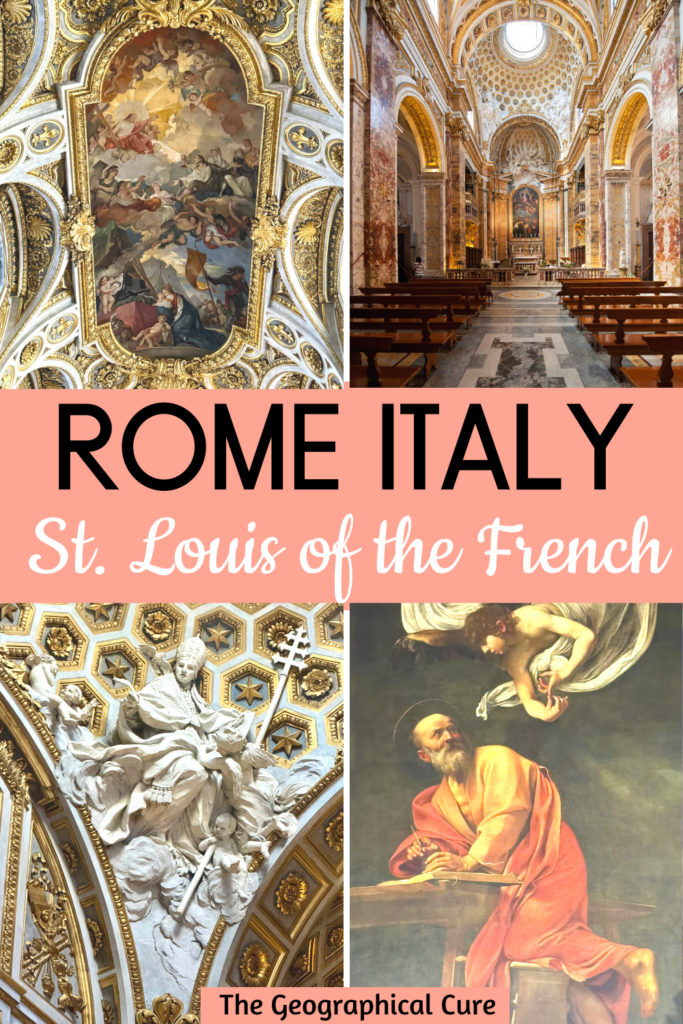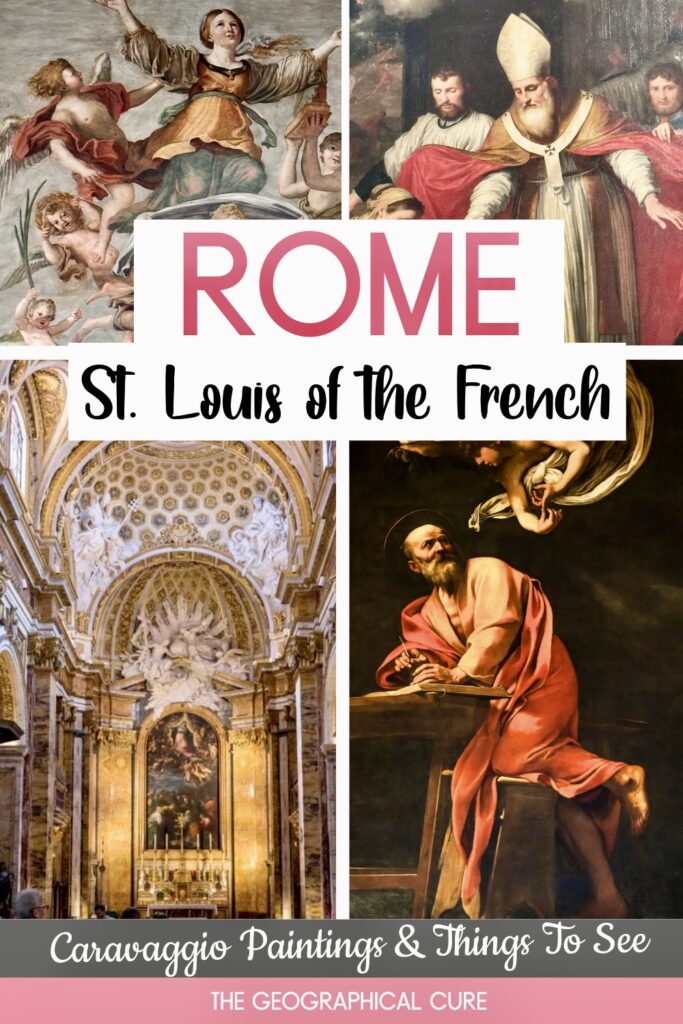The Chiesa San Luigi Francesi is a must visit church in Rome. It’s home to three celebrated paintings by the great Baroque artist Caravaggio.
The church is dedicated to Louis IX, the French king later made a saint. And it’s the national church of France in Rome. The fleur de lis of France are scattered throughout.
The Renaissance facade was designed by Giacomo della Porta, Michelangelo’s pupil, and completed in 1589.
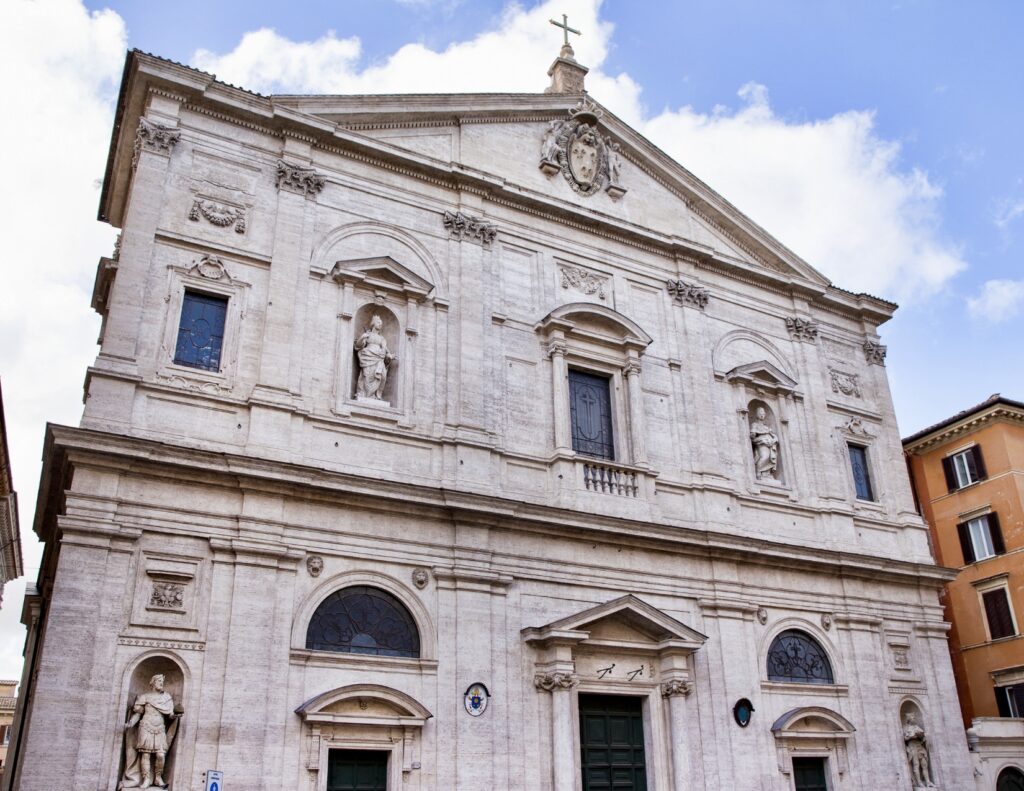
In this guide, I’ll tell you everything to see at St. Louis of the French and give you tips for visiting.
St. Louis of the French: What To See
Facade
Built between 1550 and 1578, the late Renaissance facade was designed by Giacomo della Porta. It’s built entirely of travertine marble.
There are two superimposed orders of equal height and three portals.
In 1747, sculptures by Pierre Lestache were added to the niches. You’ll see Charlemagne, Louis IX of France, Saint Clotilde, and Saint Joan of Valois.
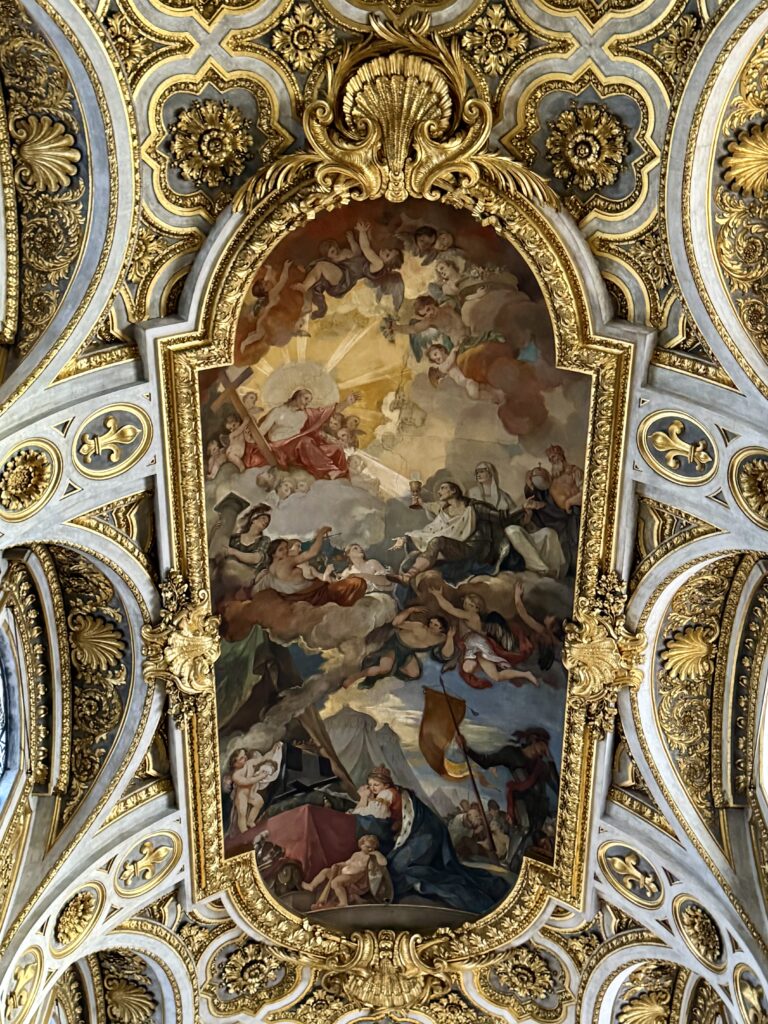
Interior
The church’s interior is masterfully crafted. It features a central nave flanked by two side aisles, all richly adorned with an array of frescoes and sculptures.
Among its most prized possessions are the exceptional frescoes by Caravaggio and Domenichino.
Dominating the central nave is a dramatic ceiling fresco that depicts Louis IX ascending into heaven. It’s by the French painter Charles-Joseph Natoire.
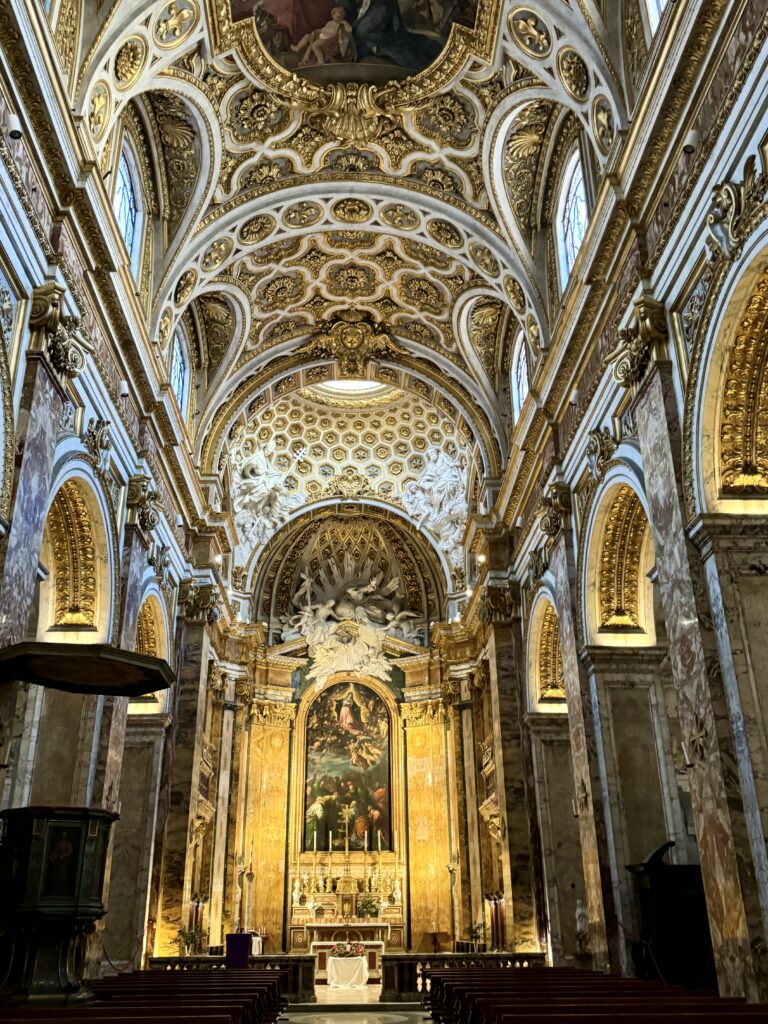
The high altar is a painting of the Assumption of the Virgin Mary by Francesco Bassano the Younger.
There are 10 private chapels, including five distinct Baroque chapels. Each is dedicated to different saints and families.
There are also several tombs of historical significance of French citizens.
The church is also home to a magnificent organ and showcases exquisite marble craftsmanship.
Contarelli Chapel
The top reason to visit the church is the Contarelli chapel in the far left corner in the back. It’s also called the Chapel of St. Matthew.
You can’t miss it. There will a horde of people gathered in front of it. It’s a well-trodden path on the Caravaggio trail in Rome.
It was decorated by Caravaggio. The paintings made him an overnight celebrity in Rome. You can see 3 in situ pieces about the life of St. Matthew.
- The Calling of St. Matthew
- St. Matthew and the Angel (also known as the Inspiration of St. Matthew)
- The Martyrdom of St. Mathew
>>> Click here to book a Caravaggio walking tour
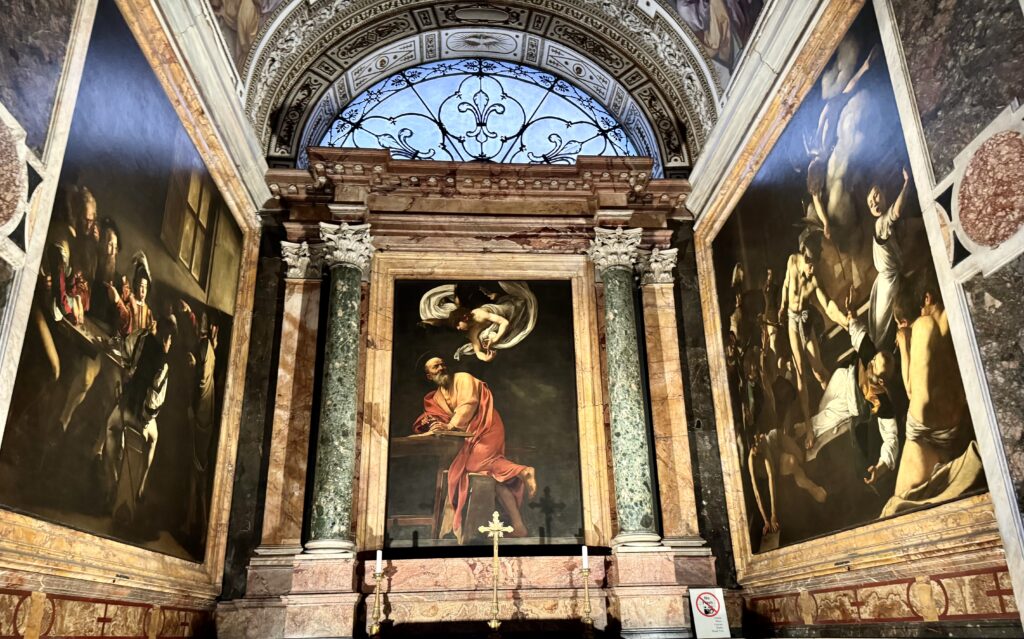
How do we know the paintings were by Caravaggio? Because there are documents!
At the age of 28, Caravaggio signed his first contract in 1599. The contract was with the heirs of Cardinal Cointerel (Contarelli in Italian) and called for him to produce three oil paintings for his family chapel.
They were the artist’s first large scale public paintings. And they have his trademark down-to-earth gritty realism and attempts to humanize the divine.
Let’s take a look at each painting.
Note: You can’t walk into the chapel itself.
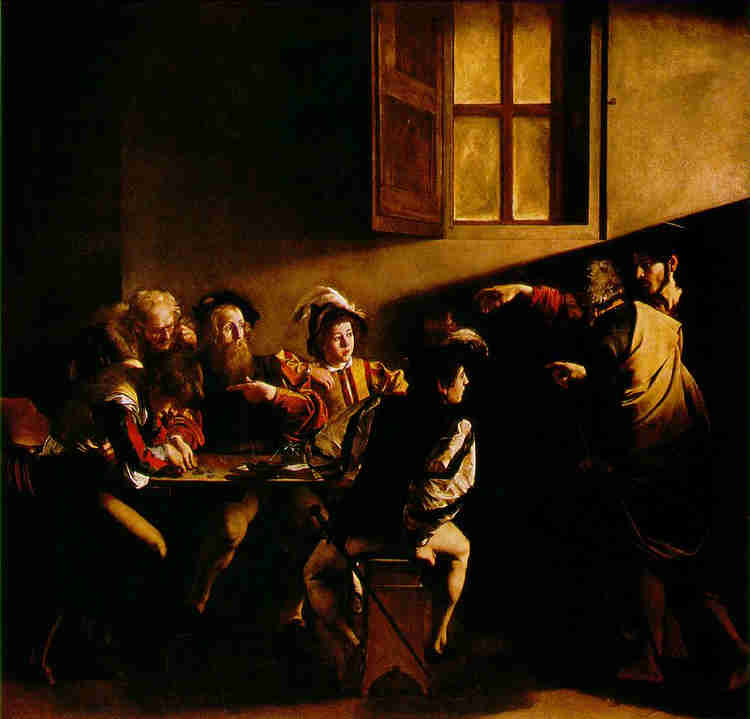
The Calling of St. Matthew
Pop a one euro coin into the machine and look first to the left wall at the Calling of St. Matthew, where the narrative begins. This is considered one of Caravaggio’s most famous and compelling paintings.
It depicts the moment when Christ “called” Matthew to follow him in his mission. Matthew is a tax collector, and is shown in his shadowy office.
Christ is on the far right, pointing his finger at Matthew. It almost looks like God’s hand in the Creation of Adam in the Sistine Chapel.
To the left, you see a bearded man in a group, who is St. Matthew. He looks almost surprised. He points to another man, as if to pass the buck.
The painting is a prime temple of Caravaggio’s use of tenebrism. Extreme contrasts of light and dark create a dramatic, brooding atmosphere.
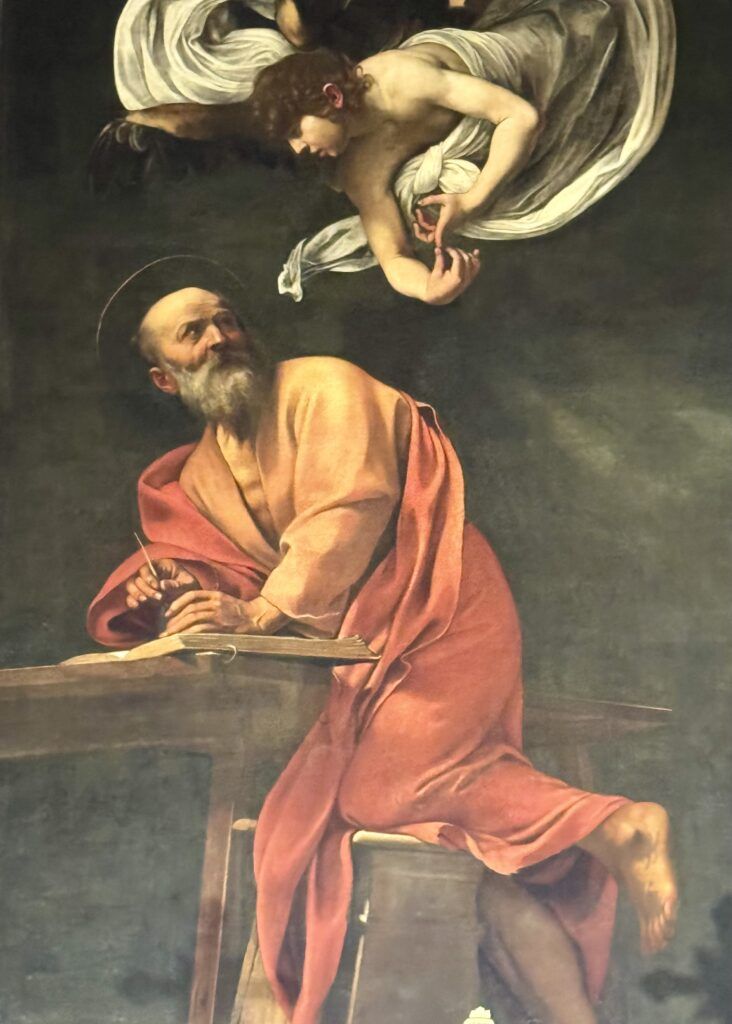
St. Matthew and the Angel
This was the third painting Caravaggio produced and it serves as the chapel’s altarpiece.
It depicts an angel, which is a symbol of St. Matthew. The painting catches the pair while Matthew is writing his gospels.
It’s a rather daring composition. The angle descends from the upper right in a swirl of drapery. You can barely see his dingy wings. With his fingers, he ticks off the generations found in the gospels.
St. Matthew looks very human. You wouldn’t know he was divine except for the faint outline of a halo.
He peers at the angel quizzically, looking concerned. He’s not used to being a scholar or having someone monitor his progress.
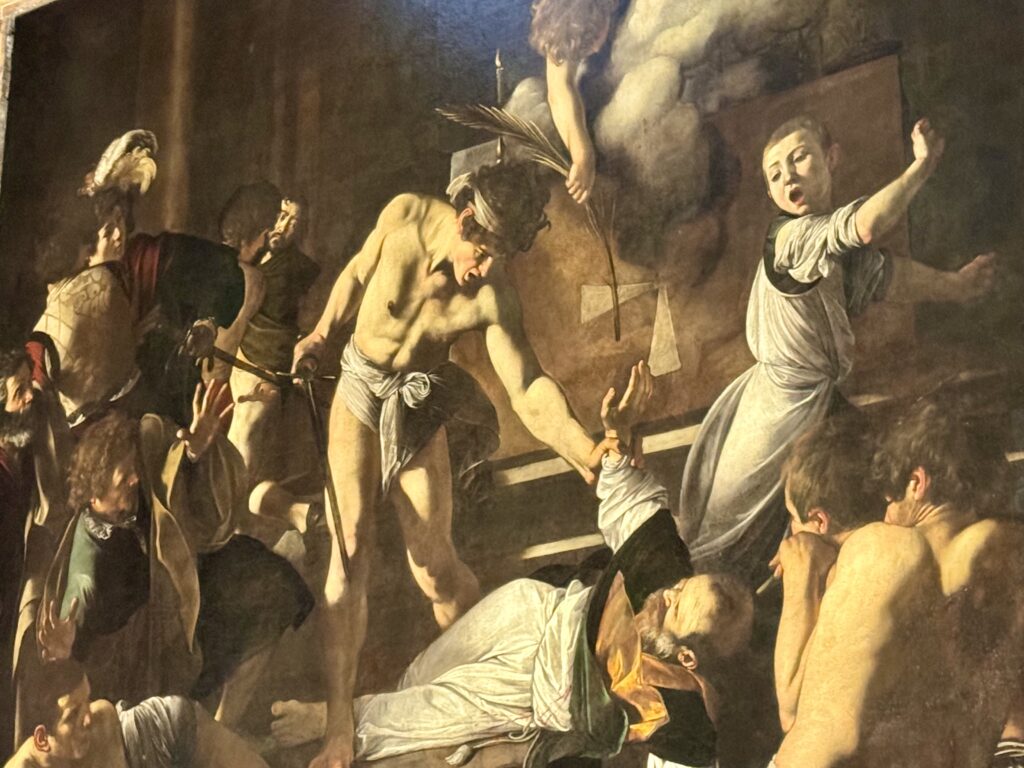
The Martyrdom of St. Matthew
Though last in the narrative order, this was the first of Caravaggio’s trio of canvases. It on the right and depicts the assassination of the saint at high mass.
Matthew spent the last years of his life in Ethiopia, creating a Christian community. But he butted heads with the ruler.
The king lusted after his young niece. But she wanted to devote her life to Christianity. Matthew steps in to protect her from the king’s unwanted advances. This angered the king, who sent assassins to kill Matthew.
It’s a singularly Caravaggio-style painting. It’s dark and dramatic and sinister, with only certain things spotlighted.
In the center, a nude man in a loin cloth has grabbed the hand of St. Matthew. He’s about to deliver the final blow to the saint.
Matthew appears to be defending himself. But, in reality, he’s reaching to the palm branch that the angel is trying to hand him.
The branch is the symbol of martyrdom, which gives Matthew immediate access into heaven. The message is that Matthew is ready to die for his faith.
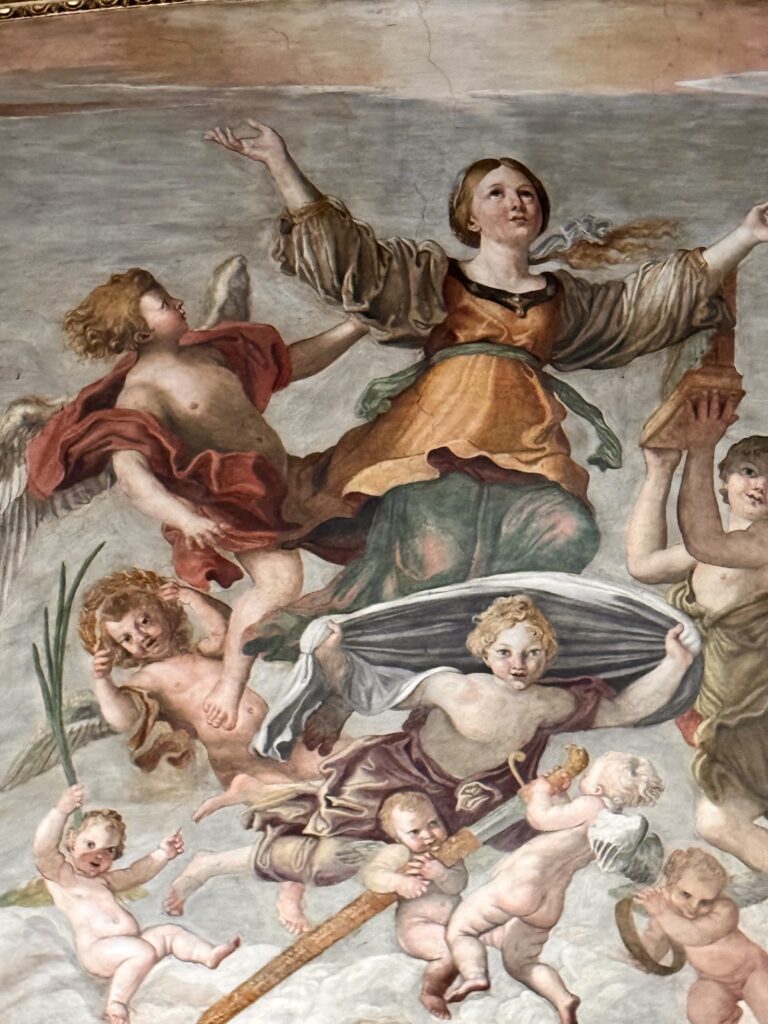
Chapel of St. Cecilia
Saint Cecilia was a young Roman martyr who lived at the beginning of the 3rd century. Legend holds that she prayed by singing, which is why she’s the patron saint of musicians.
She was incredibly charitable and converted many pagans to Christianity. She was sentenced to death during the Christian persecutions.
On the vault of her chapel you see the Ecstasy of St. Cecilia, who’s accompanied by saints and putti. It’s by Guido Reni and is a copy of one of Raphael’s paintings.
The other beautiful 17th century wall paintings are by Domenichino. They show Cecilia disturbing her wealth among the poor and her martyrdom. They are the polar opposite of the Caravaggio works.
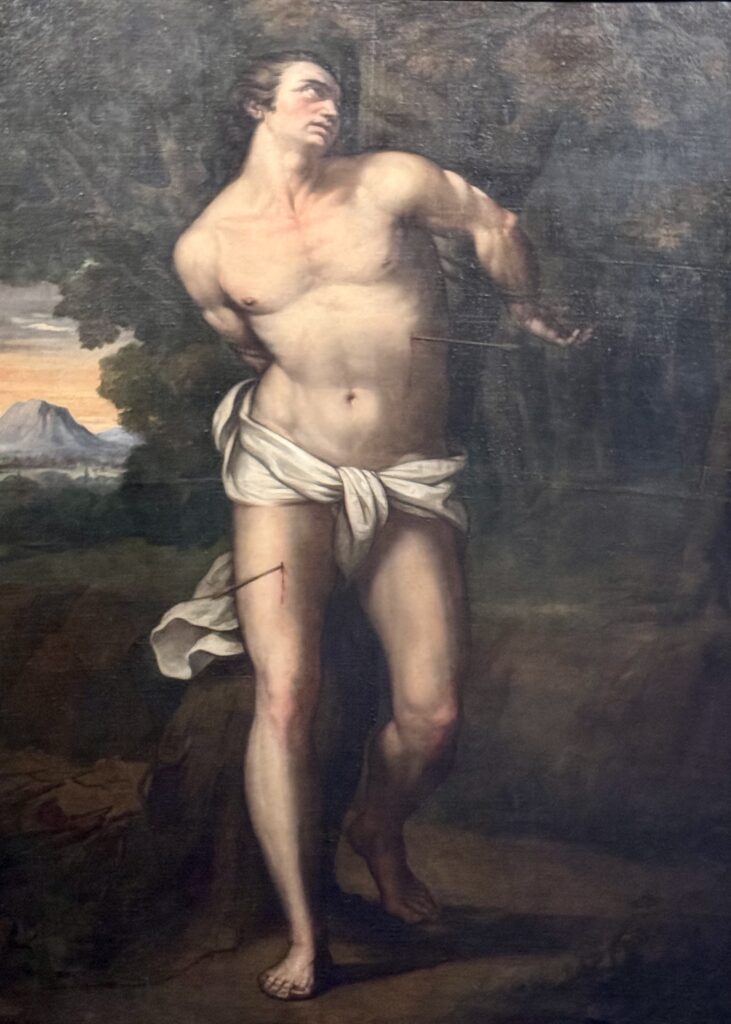
Chapel of St. Sebastian
Like Cecilia, Saint Sebastian lived in the 3rd century. He was a centurion in Diocletian’s army.
But when he helped fellow Christians who were being persecuted, he was sentenced to death.
The chapel’s center frescos show the saint’s martyrdom. He’s almost always depicted as he died — shot with arrows. There are fewer arrows in this painting than usual!
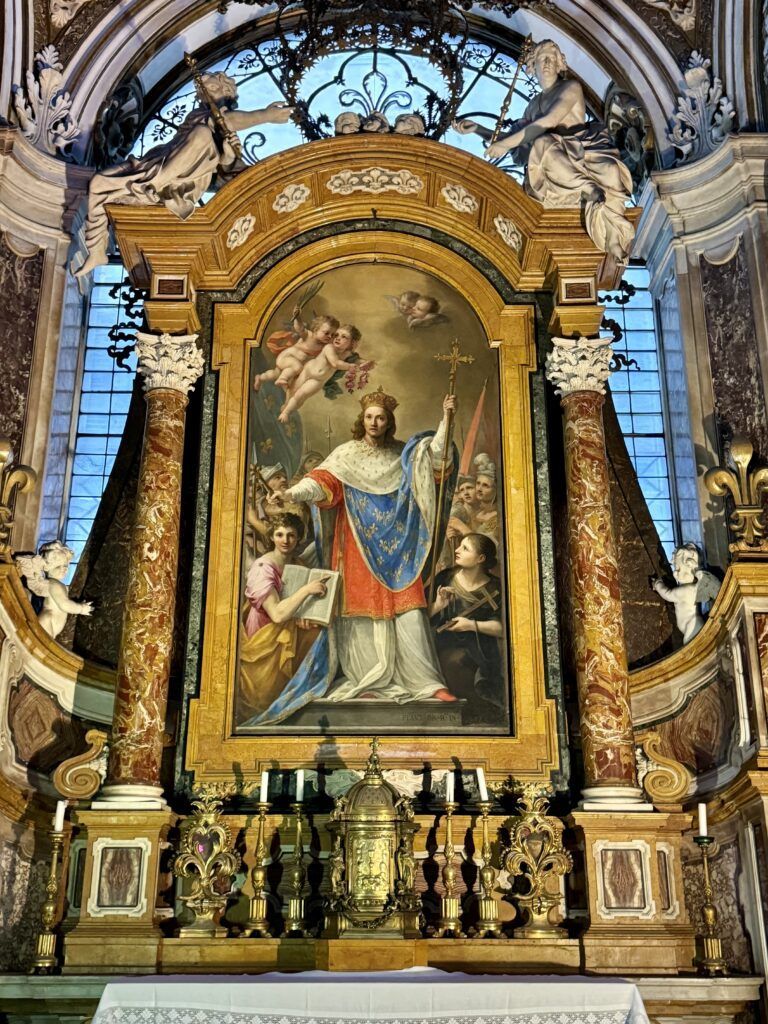
Chapel of St. Louis
Louis IX was king of France from 1126-70. He reigned with piety and was an exemplary monarch.
He defended the holy land and acquired relics of Christ, including the Crown of Thorns. Indeed, he built the exquisite Sainte-Chapelle in Paris to house this relic.
The chapel boasts sumptuous Baroque in decoration, inspired by Bernini. The center painting is by Plautilla Brice.
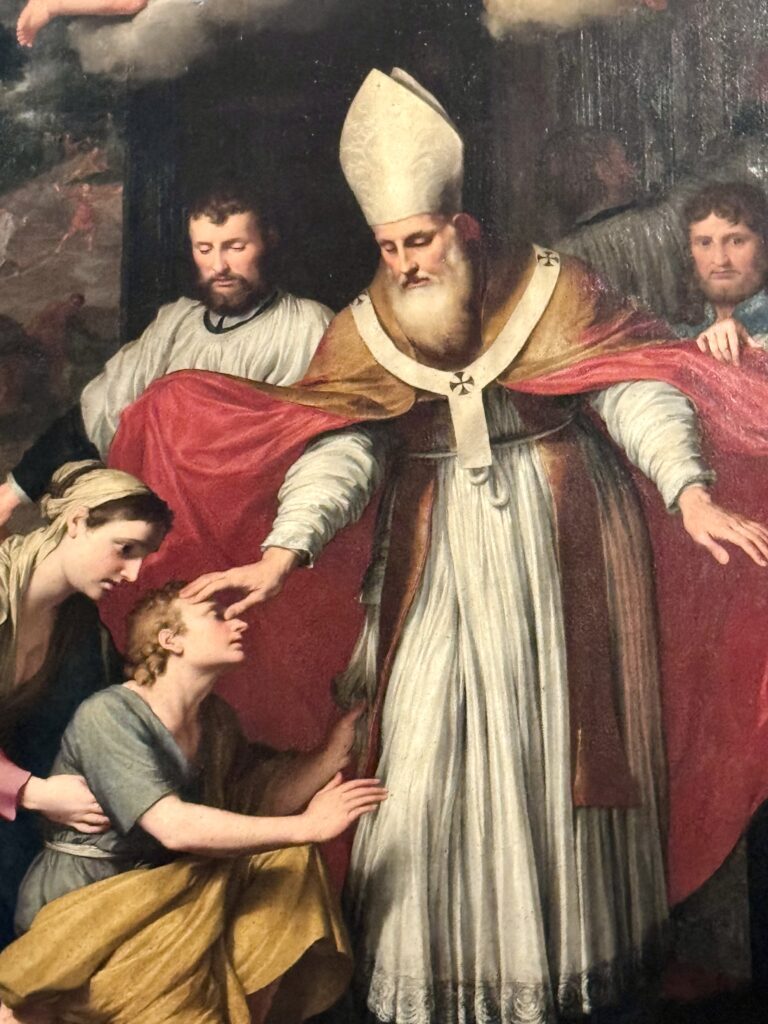
Chapel of St. Nicholas
St. Nicholas was an archbishop in Asia Minor in the 4th century. He’s known for his charity and his persistence in fighting heretics.
He’s also known for his miracles, a prerequisite for a saint of course. Legend holds that he brought three children back to life who had been killed by a butcher.
In the center of the chapel, you see a depiction of his miracle.
He’s flanked, on the side walls, by paintings of St. Catherine of Alexander and Saint Barbe. The ceiling shows scenes from Nicholas’ life.
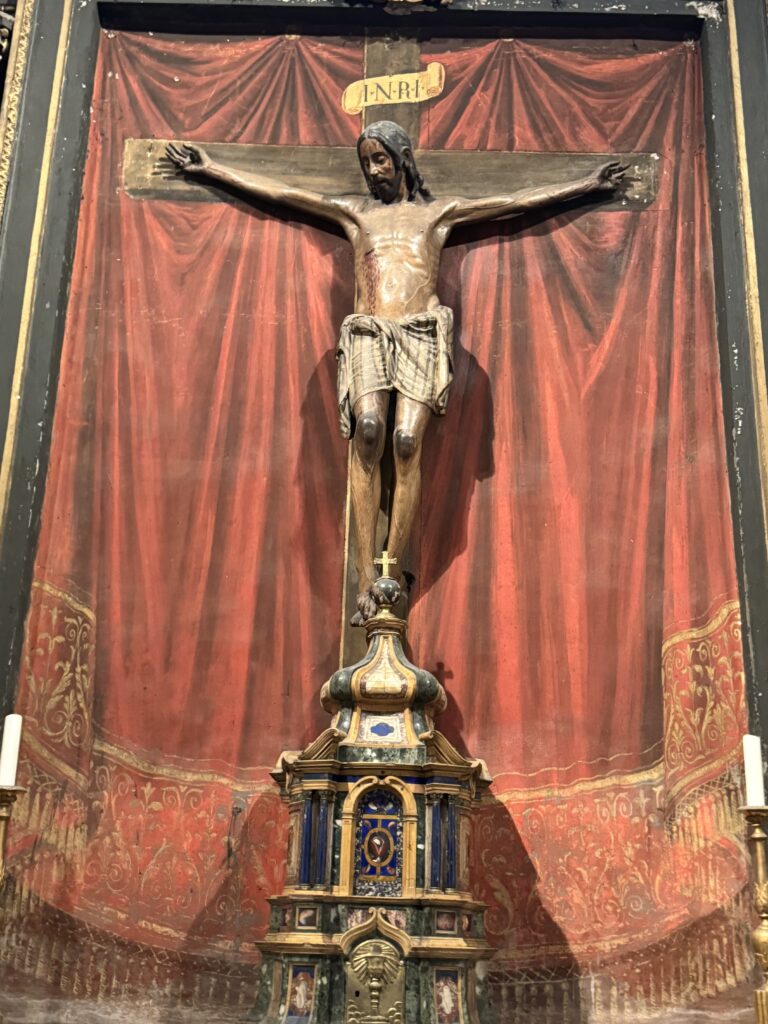
Chapel of the Cross
This chapel features a 17th century wooden crucifix and a precious jeweled tabernacle. On the wall are monuments and inscriptions dedicated to French artists and residents of Rome.
The chapel is part of the “pilgrimage of the Seven Churches.”
Beginning in 1575, an indulgence (forgiveness of sin) was given to anyone undertaking the pilgrimage in penitence. One way to do this was to visit the seven altars of the crucifixion spread around Rome.
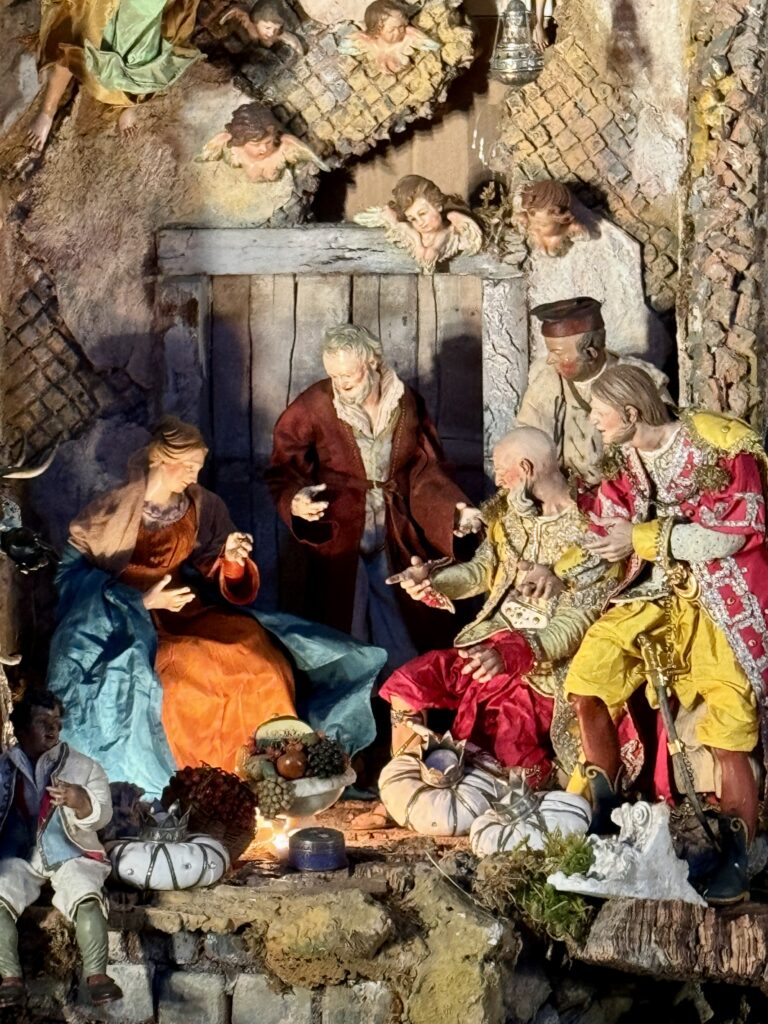
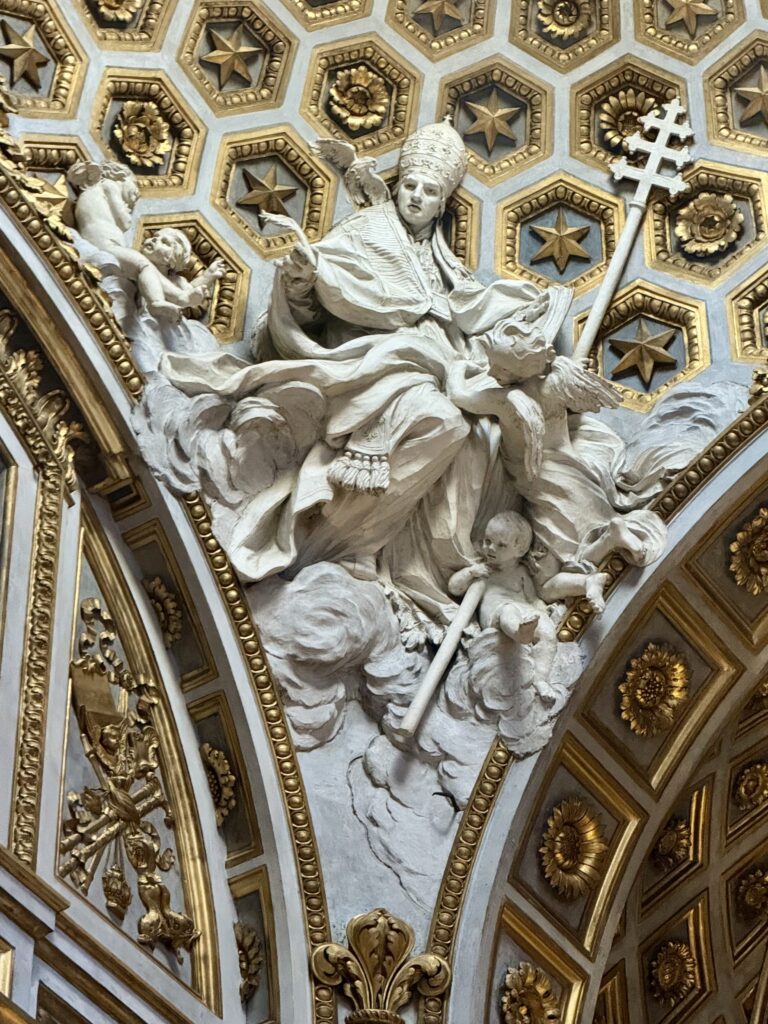
Practical Guide & Tips For St. Louis of the French
Address: Piazza di San Luigi dei Francesi 5. It’s right in between the Pantheon and Piazza Navona.
Hours: Open daily from 9:30 am to 12:45 pm & 2:30 pm to 6:30 pm
Tickets:
Admission is free. But you need one euro coins to turn on the electric lights for the Caravaggio paintings.
They are very difficult to see otherwise. But if you allow your eyes to adjust to the natural light, you can have an idea of how they were seen in the Baroque era.
You can also book a guided Caravaggio walking tour that includes the church.
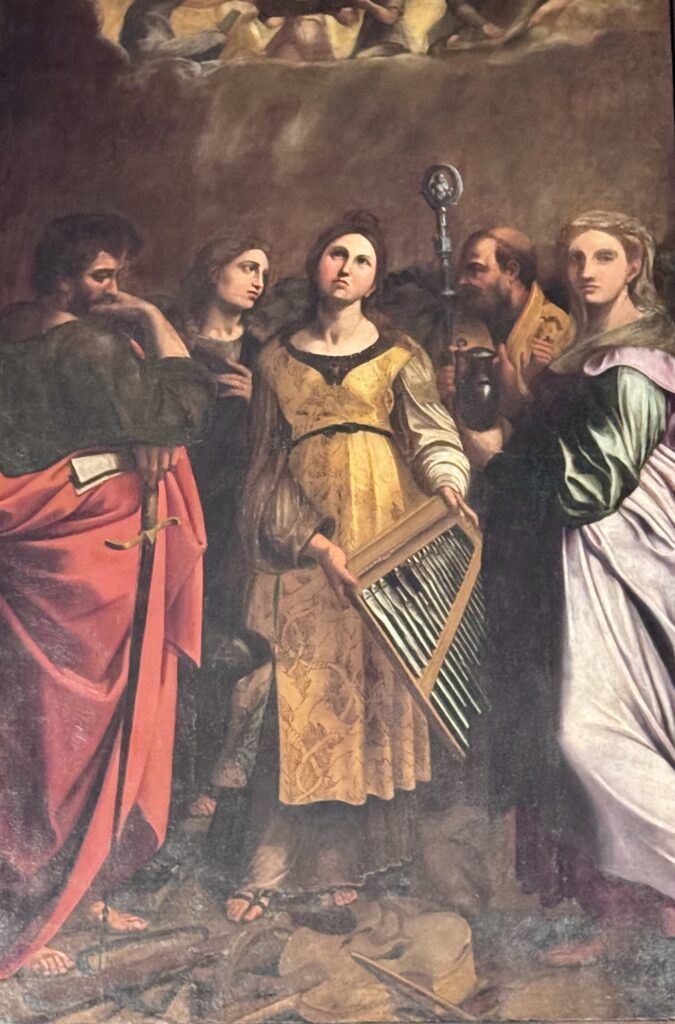
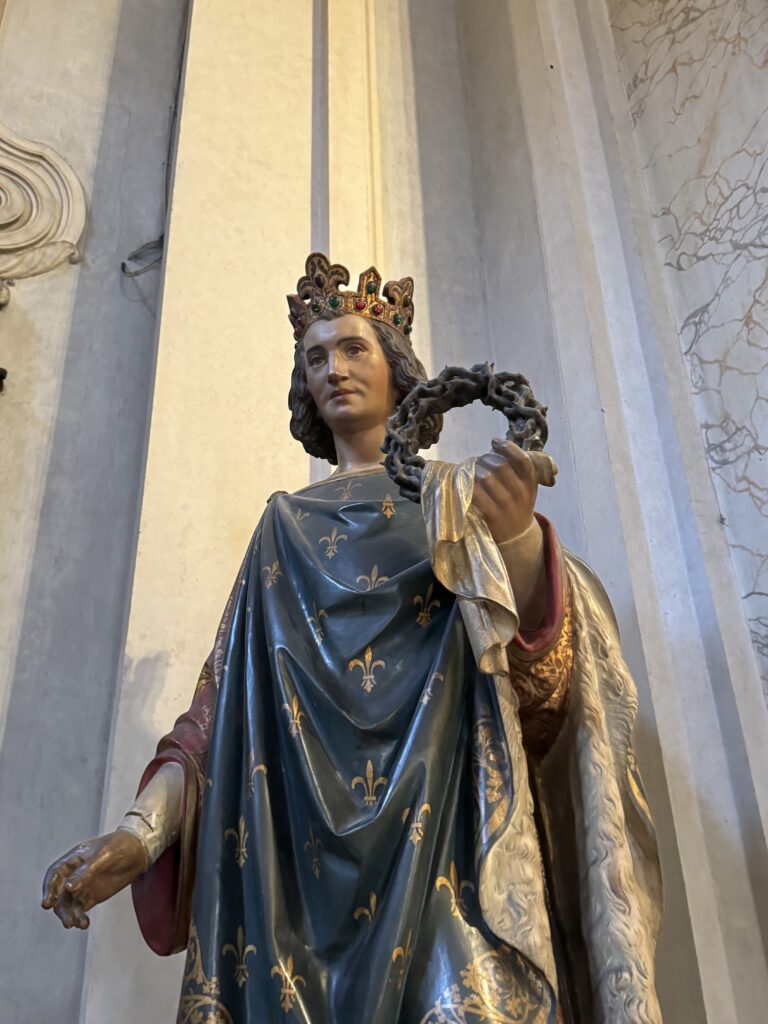
Pro Tips: You need to have your shoulders and knees covered to enter the church.
I hope you’ve enjoyed my guide to visiting the Church of St. Louis of the French. You may find these other Rome travel guides useful:
- 8 ways to spend 1 day in Rome
- 3 day itinerary for Rome
- 4 day itinerary for Rome
- 5 day itinerary for Rome
- Best museums in Rome
- Hidden gems in Rome
- Archaeological sites in Rome
- Guide to the Borghese Gallery
- Guide to Palatine Hill
- Guide to the Roman Forum
- Guide to the Colosseum
Pin it for later.

